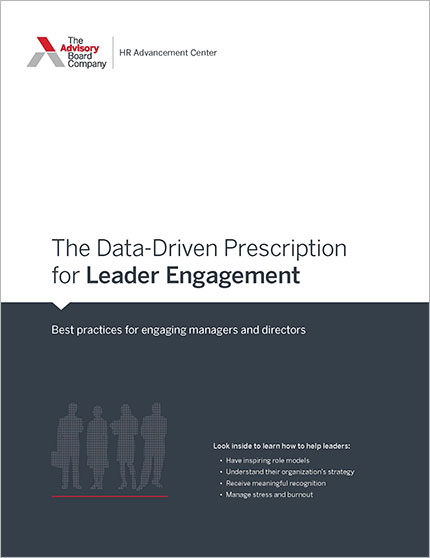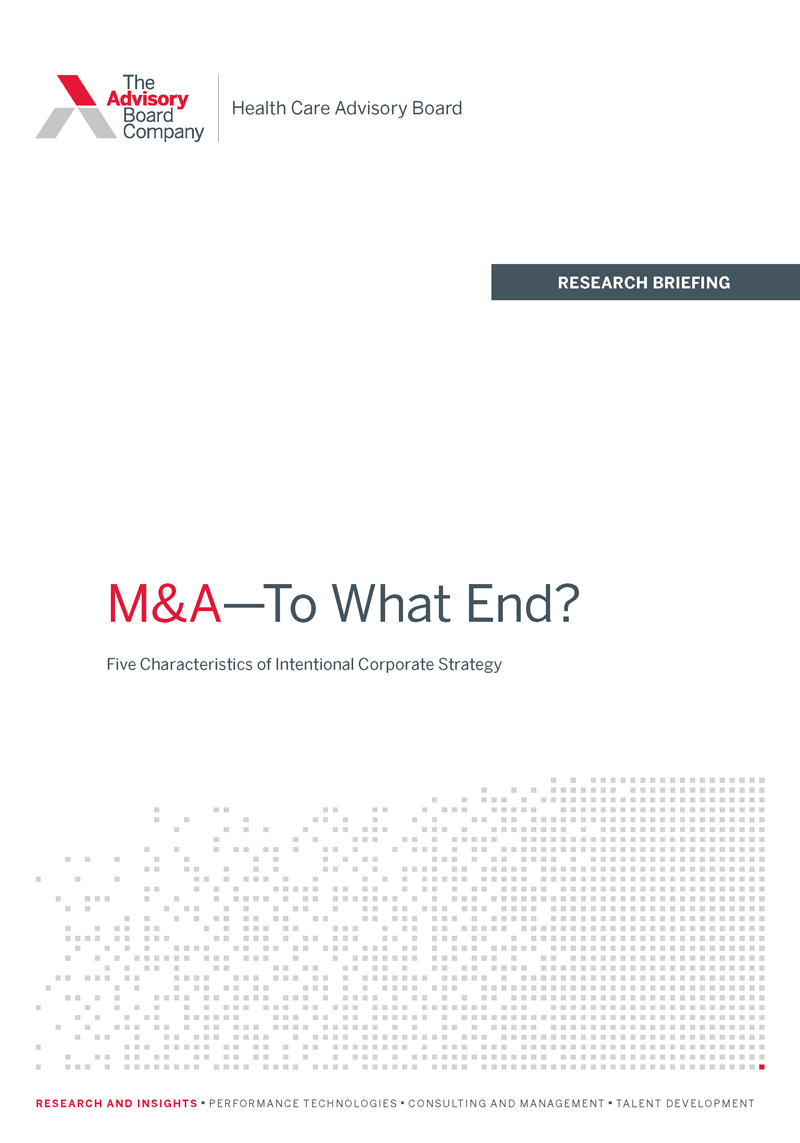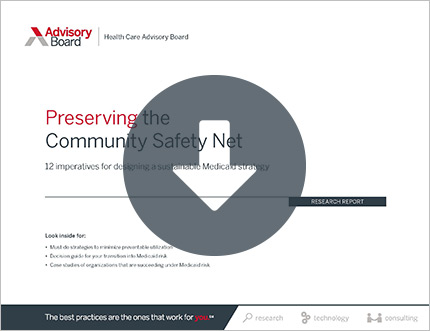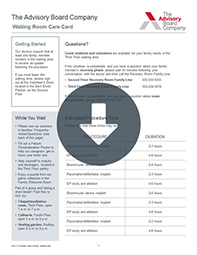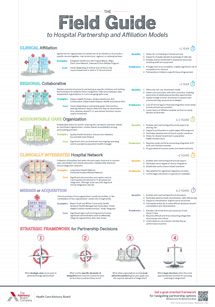Auto logout in seconds.
Continue LogoutWelcome to the "Lessons from the C-suite" series, featuring Managing Partner Eric Larsen's conversations with the most influential leaders in health care.
In this edition, Kevin Vermeer, president and CEO of UnityPoint Health, talks with Eric about his Dabo Swinney-inspired approach toward recruitment, why the industry needs to go "all in" on value-based care, and how "gratitude journals" are reshaping the culture of UnityPoint Health.
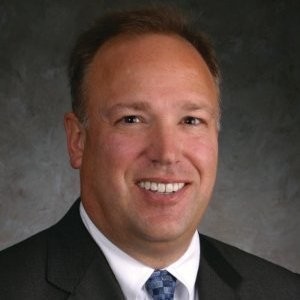
Kevin Vermeer, president and CEO of UnityPoint Health
Question: Kevin, you're an accountant by training, and you grew up thinking you'd be working in small business. I think it is a wonderful irony that you gravitate towards small businesses and yet here you are running a $4 billion, nine-market, three-state, 30,000-person system. So somewhere along your career path, there was clearly something of a left turn. As you look retrospectively on your career, Kevin, let's start with a basic reflection—why health care?
Kevin Vermeer: It wasn't a pre-ordained thing. I was working as an auditor in Deloitte's Colorado Springs office, and that office just happened to work with a lot of nonprofits and a lot of health care organizations.
I eventually realized that public accounting wasn't my thing, but then I got to work in the decision-support side at Penrose-St. Francis. And things kept growing from there: I got into analytics, expanded into growth, M&A, and strategy, and then had this great opportunity to lead UnityPoint Health.
Q: Let's talk about how that background colors your leadership philosophy and approach. You've said that even though UnityPoint Health is the 13th largest system in the country, you intentionally try to run it as a small business. Talk about that if you would.
Vermeer: My father is really my inspiration. He owned a small business, and I love the feel of a small, family-owned business where you know people's struggles and successes. It's not just a job.
So now, even though I'm working in this big organization, I've kept that small-business aspiration. I like making that individual connection with our team members. Learning more about them as professionals but as people first. For instance, a social worker in one of our regions asked her team members to keep gratitude journals. She asked me to call into the meeting (anonymously) and share the three things I'm grateful for. Clearly I said something that gave away my identity—because someone guessed it was me almost immediately—but it was so much fun because I'm a small group connector and I get energy from individual, personal connections.
That approach is vital, because it creates a good experience for our team—and when they're happy, they'll provide exceptional care.
Q: I'm curious—do you remember what you mentioned when you called in the meeting (anonymously!) to share the things you're grateful for?
Vermeer: Actually, yes I do. I'm grateful I had a father who was a tremendous role model, professionally but mostly personally. He was a busy guy, but he always made time to be at the events that mattered, and that's always stuck with me. It keeps me balanced to put my family first in the way I saw my father do it.
I'm also grateful to work with people who have great passion and genuine caring—which is probably odd coming from an accountant, but I love that aspect of my work.
And I'm grateful for my family, but especially my daughter-in-law. She's an occupational therapist who has an interest in the elderly. My wife and I have worried that our boys would not be successful at taking care of us when we get older, so we're doing all we can to make sure Megan loves us and stays with us!
Shaping culture at UnityPoint Health
Q: An inescapable part of being CEO is that folks look to you to set the tone culturally. How do you 'create and curate' that culture in an organization—especially a complex, geographically distributed one?
Vermeer: For me it means being who I am. The title of CEO carries with it an expectation of being formal but going back to that small company feel I want to be approachable and authentic. We do that in a couple different ways, including being genuine in our communication style. That means my own communication doesn't always have the most polished phrasing. The team could write far better than I speak, but they try to reflect a more conversational style.
And culturally, there's just some fundamental things—just the ethos that you believe in. I grew up playing team-based sports, so I'm familiar with the joy of being part of a great team. I think you can develop that kind of joy in a work environment, where everybody is on the same page and pulling the same direction.
That ethos also affects how we treat our physicians and team members. To paraphrase Dabo Swinney, what makes a great team isn't getting all these five-star recruits—it's loving the people already on your team. When we love and engage the people we have, then we'll attract great people who want to be a part of that without having to chase them.
Q: I did notice you chose Dabo Swinney and not Nick Saban, so that's an instructive data point! But setting that aside for a moment, you're actively doing your part as CEO to shape and reinforce the culture—how are you empowering your team to do their share?
Vermeer: Some of my best learnings come from being out and hearing about our organization from the team directly. One of my favorite groups at UnityPoint Health is the Culture Advisory Council—a group of 35 staff, physicians, and leaders from across the organization, hand-selected by their regions because they're so engaged. We've got monthly meetings, and they hold nothing back: They'll tell you exactly what's going on in the organization—and then they'll tell you, "And here's a couple different ways you could fix it."
It's invigorating to deal with people who are so engaged in making the organization better. That's where you get the energy to take on the challenges and the transformation and change that you know has to occur, because these people, they believe in it.
Going all in on value-based care
Q: One unique attribute of UnityPoint is its evolution from a single state-based system into an organization spanning three states and nine geographic regions, with vertical integration (health plan ownership) and horizontal expansion (several hospital acquisitions and partnerships). You've been thoughtful about this growth, Kevin, and even though you're in non-contiguous geographies, you've been very intentional about pursuing a value-based-care approach in each market.
Vermeer: Yes, that's exactly right. We have been purposeful about getting into value-based contracting because we fundamentally believe that providers must take responsibility for managing the health of a population. We're the only ones who can change the trend around health care spend, and we need to embrace that role. We believe in keeping people well because that's what our communities want in order to thrive.
It's also just a fact that UnityPoint Health is located in parts of the country where fee-for-service rates are really low, so our shift to value-based, shared-savings arrangements—and ultimately to full risk and reward—is the best path for our organization and our communities.
We've gone through a lot of growth. But all that growth also put a spotlight on the fact that we don't have core, standard processes. Our organization grew up as an extremely autonomous, loose federation. But the industry environment now is not as forgiving as it used to be, so we're spending a lot of time and energy establishing a system viewpoint—how we're going to collaborate and partner and share in decision-making. To be successful in value based care you have to have the discipline of a well-run business so that as clinicians can deliver the right care in the right setting.
Foundationally, however, we still believe that health care is best delivered locally. So it comes down to maintaining strong local community boards, with great leadership in each of our regions, while leveraging our larger organization to create scale through growth and better alignment.
Upcoming webconferences
Thursday, May 31
Your guide to the proposed Meaningful Use overhaul
Tuesday, June 5
Rein in labor costs—without alienating staff
Wednesday, June 13
Improve access to care for the underserved—with mobile health clinics
Q: This is a timely and material question you are raising—who should be the entity responsible for assuming population health? Lots of different industry players aspiring to be the controlling entity here—big, multi-state health systems (for-profit and nonprofit); managed care companies; and an increasing assortment of vertically integrated players (retailers, PBMs, etc.). If it is indeed UnityPoint Health and like systems, how do you tackle the practical difficulties of managing populations, especially socially and clinically complex groups like Medicaid? How is UnityPoint Health best positioned to do this?
Vermeer: I just don't think anyone else can do it. I think we've proven that nobody else can do it. And, ultimately, we're in a position—between home care and the clinic and the hospital—to see all these patients and leverage the skills of really smart people who are used to taking care of people's needs.
Of course, we need to understand that we can't do it on our own, especially in the Medicaid space, so we've got to take advantage of the great community resources out there. We know that sometimes it's not about the diabetic meds we prescribe but it's the meal that they eat that really matters. Our care givers want to be in the business of getting our patients what they need so that they know they matter.
Q: A lot of systems talk about being population health managers—UnityPoint Health has gone far beyond rhetoric and has been actively building out the infrastructure to do it. You didn't just do MSSP Track 1; you were a Pioneer and then advanced into NextGen as one of the top performers. You also tucked in a health plan through the Meritor acquisition in Wisconsin, and you launched a joint venture plan with HealthPartners in Medicare Advantage (MA) in Iowa.
Vermeer: Yes—we're approaching this from a number of different entry points. But overall, I'd say we are all in on value-based care. We firmly believe that the work that we're doing to manage populations is resulting in higher quality care. It's the care I want for my family and the care I want for our people. I even had our physicians tell me, "Don't you dare go back, because now we're delivering a better product, and it's more satisfying and fulfilling as a provider."
But we've said from the beginning that while these shared-savings relationships are great learning opportunities, they're not great financial models—especially the early ones where you had 50/50 shared savings. The financial transition is tough: Even though value-based care is our stated vision, we don't control all the pieces we need to interact with to pay us how we want to be paid.
For us, the key has been a board that's focused on the long term. They understand that the investments made today will pay off tomorrow. It's changing our definition of success relative to the levels of the key performance indicators—namely financial. Right now, that path means getting to capitation as quickly as possible, because we can't keep taking lower fee-for-service rates and expect to thrive under the old care delivery model.
So the question for us is not, "Should you be in value-based arrangements or should you fight for fee-for-service?" It's, "Well, how do we get all those other people we need for a full risk-reward situation to work with us?" And part of our answer is getting into Medicaid. If we really want to tip the scale of full-risk population management responsibilities, bringing in that Medicaid population is key—not only for our organization, but also for the state.
Q: I like how you frame the situation as a 'training opportunity' on how to get all the different stakeholders rowing in the same direction. But each constituency is distinct, and UnityPoint Health is taking a different approach with each. So let's start with your joint venture with HealthPartners on an MA plan. How are things going with the venture?
Vermeer: It's hard to grow lives. It's especially hard in a state like Iowa, where the bulk of our business has historically had very little MA penetration. And it's not a huge-population state, so it's going to be a long-term ground game. That said, at UnityPoint Health we have a commitment to learn, to figure out how to be disruptive in a mature organization, capitalize on a strong brand, and leverage a strong partnership. HealthPartners is a great partner and together we have a great opportunity. Their culture and vision are a great fit with ours, and they already had in place capabilities and assets that were efficient and effective.
But in terms of overall strategy, we basically want to receive a fixed payment and manage the population for that amount, and we'll pursue that strategy through whatever means necessary. We'll try to do that through contracting strategy, we'll try to do it through relationships with federal and state governments, and we'll try to do it through our own insurance opportunities. We're agnostic to what type of relationship that is or who it's with. Our focus is a relationship with our patients. We just want to manage and take responsibility for those populations.
Q: How open have the national managed care companies been with you when it comes to partnering for some portion of the premium dollar, some greater percentage of the ‘medical loss ratio' delegated to you? I'm curious about your experience because in some markets, the payers are showing some degree of openness to partnering and giving some degree true shared risk, while in other markets, especially if you got a monopolistic payer—and at least in one of your geographies you do have a monopolistic payer—they're perhaps less so. What's been your experience?
Vermeer: Understandably they are skeptical. Number one, I think they're bound by some of their own systems and their ability to effectively administer those types of arrangements. They're open to the discussion, and they're open to the concept—but they need to know when you'll get to where you're generating beneficial value. It's not going to work if all the value goes to us and they don't get any value, and it's not going to work the other way. We've experimented with what that looks like, because that sort of collaborative approach is a change in philosophy for our organization, too, and if we can eventually create a win-win, then I think we can get there.
It's also important to note that Iowa historically has had some experience with capitation that didn't go well, and the payers were left holding the bag when the providers couldn't pay the money back. You've got to have a different value proposition so that people can get behind the collective goals. People with long memories around bad outcomes, and they need to know why this time will be better, how it will be better, and so on. And that's where some of these early shared-savings arrangements have helped build credibility: we're demonstrating that we're serious about it, too, that we're building capabilities to better position our organizations to do well.
The big challenge is our pluralistic physician strategy. For some of these shared-savings models, we have to figure out, "Is there enough value for independent physicians, primarily specialists, to participate with us?" But I think in trying to figure out that balance, we've learned a lot—it's just working through all that, trying to demonstrate as best you can that the system is going be a good and fair partner. It's where our internal partnership and alignment is even more important because our physicians relate to the people in their market but look to the actions across the system.
Q: As you look across your $4 billion organization now, what percentage of revenue is under some kind of a pluralistic, value-based care model? And looking forward, how are you charting the course to say, "Hey, by this or that date, we're going have X number of hundred thousand lives"?
Vermeer: About 20% of our total revenue is in value-based arrangements. We have virtually no capitation today; it's varying levels of shared-savings and shared-loss responsibility. Now, if we can get Medicaid in there, if we can grow MA and start shifting non-attributed, commercial lives into more value-based arrangements—that's a good growth path.
We've got approximately 400,000 lives in our ACO, and the strategy has to be, "Well, how do we get to the next level?" How do we do use our initiatives in urgent care and other commercial strategies to move unassigned patients into a relationship that causes that patient to be attributed to us in a value-based arrangement? Because right now, we're serving way more patients for our payers than what we're getting in attribution.
Q: Let's go a bit deeper into UnityPoint Health's Medicaid strategy. I ask because right now, while about 70% of Medicaid lives nationally are under some sort of managed-care arrangement, only 40% of Medicaid revenue comes through those structures. That's because states have been slow to move the most socially complex and clinically co-morbid populations (D-SNP, TANF, ABD, etc.) into a managed care arrangement. That is changing fast. How ready is UnityPoint Health to take on these 'sickest of the sick' and socially complex populations - particularly given your pluralistic physician model?
Vermeer: On the care delivery side, we've learned a lot as we've taken more risk. You start to get more sophisticated in your analytics, and you start to target programs or resources to individuals who are most in need. We've had open discussions, particularly with our clinicians, around the philosophy of care delivery.
Now, I'm not a clinician—I can't set those principles. So I need our physician governance to weigh in and direct the strategy on this piece to ensure we can deliver. Fundamentally, I think you've got to have specialty clinics and other resources that are targeted to different populations, which may be based on payers or diagnoses or what have you.
Of course, the challenge is exacerbated when you think about Medicaid, because the needs of that population are different than the needs of a commercial population or a Medicare population. Socially complex and very sick Medicaid populations are of course much more complicated and require us to have that much more focus in our clinical delivery. So we will wind up with programs tailored to certain populations and not applicable to other ones—not because of who the payer is, but because of the needs of the patient population.
That's really where we're at. Early on in this game, it's easy to say, "We want one standard of care, we want all our programs available to all people who have that same sort of scenario"—but that's hard to do for a lot of reasons. So we've adopted a value proposition that we want to be easier and more personal to our consumers. This allows our leaders and physicians to be consumer centric and look at ways we can achieve that for different segments of our populations.
Fostering innovation
Q: I know 'consumer-centricity' is a huge priority for you personally, Kevin, and for UnityPoint Health. What does this strategy mean to you and how are you approaching it?
Vermeer: The fact of the matter is that in some of our communities, it's going to be tough to get enough providers to take care of populations, so we've got to look at ways to create access by leveraging the right mix of technology and personal touch.
And I think all these announcements lately—CVS-Aetna, Amazon-Berkshire Hathaway-JP Morgan—are tremendously helpful because they demonstrate that the health care space is open for disruption. That helps sell the message that we've got to keep evolving away from a hospital-centric organization to one that's patient-centric, provider-driven, and consumer-friendly.
And when you think about what these disrupters are trying to do—who they're going to go after, how they're going to go after it—you have to ask, "Why not us?" Because we've already got a lot of these relationships; we just need to pivot.
Of course, we also have to figure out how to segregate retail, innovation, and consumerism from the bureaucracy of a large health system. It's easy to kill all of that just because, by the nature of your dominant business, there are so many reasons to not embrace change.
Q: You just mentioned the importance of giving innovative enterprises room to grow, and implicit in that is ensuring that our entrenched bureaucracy doesn't suffocate our fledgling efforts... How do you think about innovation as a concept?
Vermeer: For us, the initial driver of innovation is a culture of entrepreneurship, creativity, and people willing to say, "Why not do it this way?" It's creating a framework—culturally and structurally—that encourages and captures the innovative ideas of people willing to challenge the status quo. Second, it's investing in those great ideas, whether that's developing a new product or partnering with others. Third, it's about tapping into the talent of your people. We have 30,000 team members whose insights need to be heard. I don't care what your title is. If your idea creates the right outcomes, we need to seize the opportunity.
It's also figuring out the right balance of separation, because areas of innovation can't be too disconnected from the organization without negative ramifications. Our primary care providers, for instance, are going to have a vested interest in urgent care development plans or other technology-based ways to provide care.
Q: Some people approach innovation with a focus on prototyping and ‘fast failing,' while others take a more cautious, ‘radical incrementalism' approach. How do you think about that balance?
Vermeer: We're huge proponents of piloting, and that's one benefit of being a large system spread across very distinct geographic regions—you have the ability to try something in a given space, see if it works, and then apply it at the right places at the right time.
Now, we don't always fail as fast as we should, because it's hard to admit failure when you think you've got a great idea.
Growth in a changing industry
Q: What are your thoughts on all these new integrations in the health care industry—not just Amazon-Berkshire Hathaway-JP Morgan, which you touched on earlier, but also CVS-Aetna, Dignity-CHI, Optum and DaVita Medical Group?
You pointed out how these new alignments were good for UnityPoint Health because it helps create impetus. But at the same time, these organizations have very different and sometimes incompatible views of what the health care system will look like. I'm interested in how those views compare—and perhaps affect UnityPoint Health's view on growth?
Vermeer: I think these integrations should be taken as a shot across the bow. If you don't believe yet that something needs to significantly change in health care, if you think that everything is going to go back to the way it was, you have to change your perspective.
Now, I have no issue with continued horizontal integration, and we'll continue to look at that, but we're not going to add a lot of value by continuing with the same-old, same-old. Getting bigger just by itself isn't the answer. You need to figure out what unique things you can take to potential partners to maximize value in the community. Our consumers want an easier and more personal healthcare experience and it's up to us to intentionally create that for them.
For UnityPoint Health specifically, we'll keep looking to get bigger, but we'll do it very purposefully, with the right relationships and right visions and the right types of organizations. And we'll look to partner with others who are not in our industry who can help solve some of our challenges.
Q: Turning to your physician alignment strategy—you and UnityPoint Health have taken a unique and progressive approach to growing physician leaders—you launched the Physician Leadership Academy in 2011, and as of 2016, I think about 60% of the folks who participated in the initial class had taken on leadership roles across the system. How do you think about being hospitable to physicians who want to be employed and physicians who want to be in your CIN, and how does this approach inform your physician recruitment philosophy?
Vermeer: We want to continue to be pluralistic, so we want to have a fantastic, employed, multi-specialty group. They are the future. We need to keep feeding that group, and challenging that group, so they can help us innovate as leaders moving forward. This is a group that I rely on for insights on strategy and engagement. But at the same time, we don't need to employ everybody, and we can't afford to employ everybody.
So the question is, how do we get better and better at establishing relationships that create alignment? It's great to have the vast majority of independent providers do business at our hospital, sure, but we have to create even tighter alignments so that physicians want to engage with us and trust us to enter into these deeper value-based arrangements.
We've also tried to position ourselves so that for physicians who don't want to deal with being independent, there's no place they'd like to work but UnityPoint Health. And that ties directly back to the culture and environment, the workflow and processes that we've established.
Q: How would you characterize the personality of the clinic and physicians? How do you think about messaging to bring them along and be successful?
Vermeer: UnityPoint Clinic came into existence in 2011 or 2012; before that, we had some employed physicians in a separate enterprise and some employed at our hospitls. The migration of all our employed physicians into a single enterprise isn't without the expected challenges around authority and decision-making. But it's maturing, and I think a big key to our approach has been engaging the Clinic early—sometimes first—in helping us solve strategic problems.
For instance, as we look at Medicaid, we went to the physician governance council of the Clinic as our first stop and said, ""Look, we need your input because we know that employed physicians—not the hospital—are going to be the ones who figure this out.""
It's putting our words into action. We said we want to be a provider-driven organization, focused on putting patients first and recognizing the clinic as the front door of the health system. And by involving physicians now, in these deep strategic conversations, we're establishing the trust needed to build that future.
Wrapping up
Q: I'd like to pivot and talk about your predecessor, Bill Lever. Bill is someone we all appreciate and admire, and I think we can agree is a confirmed extrovert. How did you two hand off the transition of the CEO role, given that by your own self-description you are more of an introvert?
Vermeer: Bill was a great mentor, a very down-to-earth guy, but as you said, he generated a tremendous amount of energy from people. It's a very different style. And he didn't necessarily say ""Do this, don't do that"" when he left, but he imparted a few things: Don't try to be a different leader than you are. Be genuine, and lead in the way you want to lead, not in the way he led or others led.
He also imparted the importance of the relationship with your board—knowing the balance between being transparent and knowing your role in governance and not burdening others. Bill was a big culture guy as well, a huge talent in succession development, and he reiterated a lot of that—bringing a systematic approach to identifying and developing talent, creating succession plans, that kind of stuff.
He also talked about recharging. You're operating in such a pace and under such pressure that you've got to be purposeful about recharging, because everybody is watching you, how you look, and how you act, and they'll notice if you are frustrated or tired.
Q: And for an introvert, the public obligations of a CEO can be exhausting. How do you recover and regenerate? What are your counterbalances?
Vermeer: I recover a lot better than I used to. I make sure I have days off on my calendar to recuperate from big events, and I space my time off accordingly. I've learned over the years that if you don't control your calendar, no one's going do it for you. I also make a point to enjoy family time—whether it's my kids' sporting events or just family time on the weekend.
And I'd like to golf more. You know, I say that every year and it doesn't work, but I believe there's a renewed energy and restorative value in exercise.
Q: Looking back, how different is the role compared with what you expected or anticipated it would be when you took the job?
Vermeer: I think I underestimated the amount time and energy I'd devote to the transformation of our own organization and the industry as a whole. And the internal transformation is almost tougher, because I firmly believe that as we harness all the talent and passion in the organization, we can take on anything the external environment will throw at us.
So the biggest challenge is aligning this geographically spread, autonomous organization and culture in a single direction. But once we do that, I don't think there's anybody that will stop us.
Q: We talked a lot about transformation, Kevin —external, internal, and even the pace of change—so I want to ask: How have you transformed personally since you took the CEO role in 2016?
Vermeer: I think I've become more patient or, as my leaders would say, maybe more realistic, because it always seems as if things should move faster and more easily than they do. I've learned the impact that a board has on helping to evolve and transform an organization for the long term. I'm also working on stepping back from my old role; as you come out of the CFO role, or the strategy role, or the M&A role, it's hard to step back and let other people grow into those jobs. They may not do it the same way that I did it, so it's a hard transition—a necessary one, but a hard one—both for me and probably for the people in those roles. I've learned to invest in the team you want and then work hard to give them the energy and insight to do great things. That to me is the balance of what I've always wanted in having a high performing team who truly believes in each other. With that we can do amazing things.
Don't miss out on the latest Advisory Board insights
Create your free account to access 1 resource, including the latest research and webinars.
Want access without creating an account?
You have 1 free members-only resource remaining this month.
1 free members-only resources remaining
1 free members-only resources remaining
You've reached your limit of free insights
Become a member to access all of Advisory Board's resources, events, and experts
Never miss out on the latest innovative health care content tailored to you.
Benefits include:
You've reached your limit of free insights
Become a member to access all of Advisory Board's resources, events, and experts
Never miss out on the latest innovative health care content tailored to you.
Benefits include:
This content is available through your Curated Research partnership with Advisory Board. Click on ‘view this resource’ to read the full piece
Email ask@advisory.com to learn more
Click on ‘Become a Member’ to learn about the benefits of a Full-Access partnership with Advisory Board
Never miss out on the latest innovative health care content tailored to you.
Benefits Include:
This is for members only. Learn more.
Click on ‘Become a Member’ to learn about the benefits of a Full-Access partnership with Advisory Board
Never miss out on the latest innovative health care content tailored to you.
